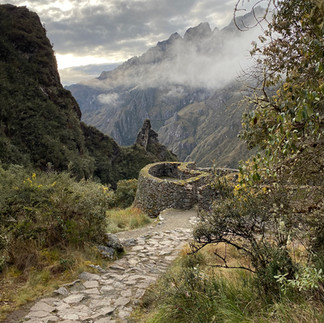Peru 2022 - Life Lessons on the Inca Trail
- Joyce Zilinski
- Jul 18, 2022
- 4 min read
Trekkers from around the world come to Peru to walk in the footsteps of the Inca on a trail built at the height of the Incan empire in the 15th century. The trail connects Inca sites in the Sacred Valley and culminates at Machu Picchu, situated on a mountain ridge 2,430 meters above sea level.

The classic trek is not long (~42 kilometers) over 4 days/3 nights, but is challenging as it winds its way up, down and around mountains, snaking its way over three high Andean Mountain passes.
In 2021 while pondering options to kick off post pandemic travels Peru and the Inca Trail captured my attention, as it would be 20 years since I had been there in May, 2002. I was motivated by the challenge to prove that “age is just a number” and I would be able to complete the 4-day trek to Machu Picchu as easily I did 20 years ago!
However, the best laid plans sometimes throw us a curve ball. Injuries to my right knee prevented me from properly training. Miraculously the week before the trip my knee felt pretty good and being an optimist, I expected to be good to go. Everyone has their own personal journey on the Inca Trail and this is how it went for me:
Day 1

Our group starts off fresh and excited at the trailhead known as Km 82. A moderately challenging walk today – the elevation gain is 300 meters over 11 kilometers. I am slow and steady and my knee supported by a super brace and hiking poles is okay. Arriving at camp is humbling as the porters who carry the gear have the camp set up and greet trekkers with clapping and cheers.
Day 2

Our guide who had been monitoring pace said I should take an earlier (head) start. I am on the trail at 5:30 a.m. as the sun is rising. It is a beautiful and meditative start to the day.
Day 2 is only 1 km. more than Day 1, but elevation gain of 1000 meters in the first 8 kilometers to the dreaded Dead Women’s Pass at 4200 meters, followed by another 4 kilometers down to Camp 2 at 3,500 meters makes it more challenging. The climb and the stairs soon feel relentless and with elevation gain my heart rate and breathing is laboring to keep oxygenated. My left leg starts to feel the strain of compensating for the right knee. No option but to keep moving. At Dead Women’s Pass I look down and am amazed to see how far and high we have come. The trail down is easier on the heart and lungs but harder on the knees. At one point my left foot slips on a rock and my ankle twists. This is not good and it slows my pace even more as I gingerly step and wince down on the uneven stone steps. Finally, the campsite is visible as the sun is setting – a 12+ hour day!
Day 3
Today there is 16 kilometers ahead of us. The trail will take us down about 1,800 meters but in true Inca style this is not a steady down but more up and down over relentless stairs. The landscape changes to sub-tropical and there are many birds, flowers and vines as a distraction from the aches and pains. My pace is very slow as I have to lead with my sore right leg to compensate for the twisted left ankle. In the afternoon we have a rain deluge – it is warm and creates a nice energy but it means the stones are slippery. The rain continues to fall for a long while and energy starts to wane. I finally make it into camp about 7 p.m. – on the trail for over 13 hours. After dinner we have a farewell with our crew of porters, cooks and guide. Most of the porters are either farmers or young men who studied tourism and need to work as porters for the income. We are so grateful to them and hope the generous tips we share compensate for their hard work.
Day 4
The goal is to get to Intipulka – the Sun Gate by about 6:30 a.m. to watch sunrise over Machu Picchu. It is a short distance of 6 km but still challenging especially on one set of stairs so steep a ladder style ascent is needed. By the time I reach the Sun Gate it is well past sunrise – but good news - there are few trekkers around so there is an uninterrupted view of Machu Picchu in the distance.

A further two kilometers and I made it! Tears of wonder and relief as the friendly face of Alim our G Adventure guide greets me with a hug.
So how do I feel about my experience? For the first few weeks the chatter in mind was all about the disappointment in my slow performance. But in retrospect, I know I learned and benefited from the challenge and pushing through to the end. Should I have even ventured on the trail without properly training and with a bad knee? Not advisable, but with the aches and pains forgotten, I am left with so many good memories of all the sights and experiences of wonder gained through this 4-day journey of perseverance.
Tips for the Inca Trail – best time to trek is dry season May to October. Book your trip well in advance – (six months to a year). Permits are limited to 200 trekkers daily. Only licensed operators can get permits meaning you have to trek with a licenced guide/company.
Our tour operator was G Adventures and the trek was one component of an outstanding 14-day Iconic Peru itinerary.
Note - It is perfectly acceptable to experience Machu Picchu without the arduous trek! A train can take you to the town of Agua Caliente and a bus up to the base of Machu Picchu & Voila you are there.


























